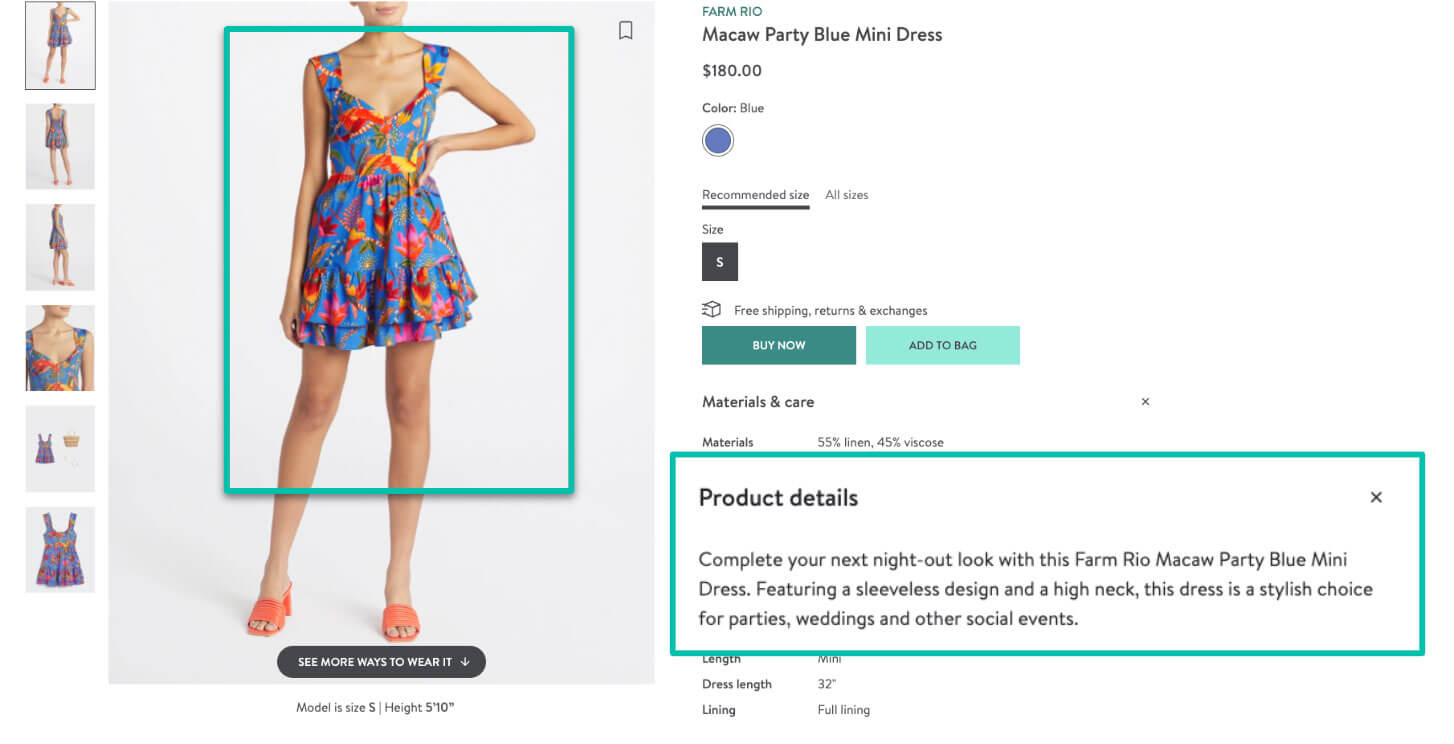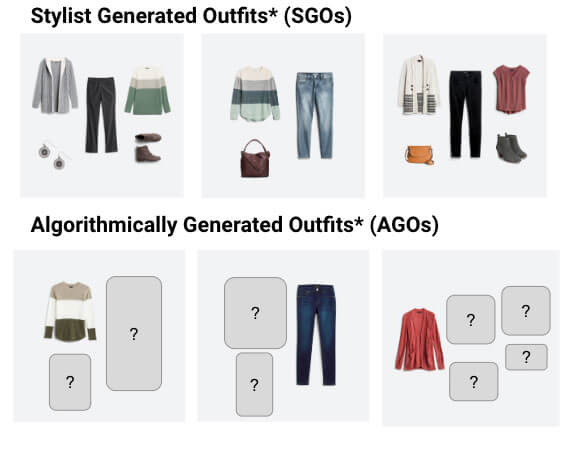How We’re Revolutionizing Personal Styling with Generative AI

While many companies are only just starting to define an AI strategy, Stitch Fix was built on data science from day one. Our belief is that humans and machines are more effective when working together and we leverage their unique individual strengths and capabilities throughout our business. AI and ML models underpin our operations and ability to personalize experiences, from client styling and logistics to inventory management and product design. As such, we are always exploring ways to utilize the latest advancements in data science.
One of the most recent breakthroughs is generative AI, which enables the production of original content through extensive training on vast datasets. Complimenting our proven art and science approach, this new form of AI is helping to support our business and provide better experiences for our clients by automating time-consuming tasks, therefore freeing up our experts to focus on uniquely human activities where they can apply judgment and creativity, such as building relationships with clients or understanding nuanced style requests.
Although this technology is still evolving, there are already a number of ways we are leveraging generative AI to unlock value from the nearly 4.5 billion textual data points clients have shared with us as we continue to drive increased personalization at scale. This is broadly broken down into three different areas:
- Using embeddings from large language models within our own algorithms to better understand textual client input
- Routing our own data through large language models to generate text
- Our native outfit modeling capabilities
Integrating embeddings from OpenAI’s large language models to better understand textual client input
Large language models, such as OpenAI’s GPT-4, are pre-trained on vast amounts of data across the internet and can understand and generate natural language. They utilize embeddings, which are numerical representations of words, phrases or sentences, as a fundamental component of their architecture. These vector representations enable the language model to understand and reason about the meaning and relationships between different words or texts.
We use OpenAI embeddings within our deep learning recommendation algorithms to interpret the textual feedback our clients share with us. When a client requests a Fix, our algorithms interpret the information the client has shared with us about their fit and style preferences to surface a selection of recommended items to our stylists. This enables stylists to easily curate pieces for the Fix instead of manually sorting through the thousands of pieces in our inventory.
Much of the feedback clients share with us about their preferences is in freeform text. For our long-standing clients who have had tens and even hundreds of Fixes, this is a lot of words and text to decipher. The OpenAI embeddings allow us to take that information and make sense of it quickly by summarizing it in a way that our algorithm can read directly. This not only improves the speed of recommendations but also enables our algorithms to surface higher-quality recommendations that are even more tailored to each client’s unique needs.
Using OpenAI’s GPT-3 in combination with our own data to support our experts with text-generation
In advertising, GPT-3 helps us to efficiently and effectively produce engaging copy.
One way in which we communicate the benefits of Stitch Fix’s service is through online advertisements. Advertising headlines are often the first interaction we have with potential clients, so it’s crucial to make them engaging. Considering the overwhelming number of advertisements clients come across, it becomes imperative for our headlines to be both relevant and attention-grabbing in order to distinguish ourselves.
The ads we display typically consist of outfits to illustrate the range of styles we offer. Creating compelling copy to accompany each ad can be time consuming, so we use GPT-3 to generate these based on style keywords or product attributes we input into the model. Once the AI has generated the copy, our copywriters quality-check it to ensure it describes the outfit in the most accurate and compelling way.
Today, each advertisement we display on Facebook and Instagram is algo-generated and quality-checked by an expert. Prior to GPT-3, it would take roughly two weeks to plan and strategize each advertising campaign and draft the asset copy. Now, on average, it takes less than a minute for copywriters to review each asset and they receive a 77% pass rate.
GPT-3 helps us generate informative product descriptions.

We use product descriptions to provide our clients with essential information about the features, specifications, and benefits of the styles we carry in our inventory. Within our Freestyle offering, where clients can shop for individual items in their own personal shopping feed, product descriptions help clients understand what they’re buying, how the product fits and feels, what occasion it is best suited for, etc. Detailed product descriptions also help our stylists better pick the items that are right for each client when curating and sending a Fix.
Writing, reviewing, and approving descriptions for hundreds of thousands of styles in our inventory is a daunting task for copywriters alone, so we trained OpenAI’s GPT-3 on several hundred existing product descriptions written by our copywriters, as well as the nuanced feedback our clients share with their stylists (for example: “this dress was more formal and would be great for a wedding,”) and product attributes from our brand partners. By understanding our language, style, and template for high-quality product descriptions, the model can quickly create descriptions for the thousands of products we have in our inventory, which our expert copywriters and merchandisers review for accuracy.
GPT-3 allows us to generate 10,000 informative product descriptions every 30 minutes, each of which can be reviewed in less than a minute. We’re able to test multiple iterations per item, ensuring we have the most accurate and creative copy, without giving our human experts more work. This streamlined process has allowed us to create descriptions for items where there previously weren’t any, while ensuring existing product descriptions are timely and tailored to certain trends and occasions.
Our “expert-in-the-loop” approach allows us to leverage the efficiency of generative AI while still maximizing human expertise for oversight. For our content experts, reviewing algorithmically generated advertisement copy and product descriptions saves a significant amount of time and effort compared to writing net-new.
GPT-4 can help our stylists better understand our clients’ preferences
Our clients share detailed information with our stylists when they request a Fix. For our most loyal clients this means they could have shared 10s or even 100s of notes with our stylists, making it a significant task to review all of their previous requests and feedback. Using OpenAI’s GPT-4, we can efficiently distill text on a large scale and generate concise recaps. One way this could benefit our clients is by enabling our stylists to quickly grasp the client’s preferences, dislikes, and other pertinent style and fit information to more accurately pick items that work just for them.
Our native applications are expanding the definition of what generative AI can be
 Our outfit modeling capabilities diverge from today’s conventional definition of generative AI, however they exhibit many similarities to large language model approaches.
Our outfit modeling capabilities diverge from today’s conventional definition of generative AI, however they exhibit many similarities to large language model approaches.
Clients come to Stitch Fix for inspiration. One way we provide inspiration is by helping them better understand how to style items they will potentially purchase – or items they already own from us – within an outfit with other, shoppable items.
Every day, we showcase approximately 43 million outfit combinations to our clients through various touch points – either within their personal shopping feeds or through personalized emails and ads. Because our inventory is constantly changing, and we want to make sure what we show clients is timely and tailored to trends, we need to generate 13 million new outfit combinations every day. To do this, we created the Outfit Creation Model (OCM).
Trained on millions of outfits that are created by our stylists, OCM considers real-time items in our inventory and clients’ preferences and past purchases to compile outfit suggestions. We can show these to clients in their individual shopping feeds as they are viewing items. By displaying personalized outfits, our clients gain valuable insights into the versatility of their wardrobe, ensuring a fresh and exciting style experience.
The future of generative AI at Stitch Fix
We’re continuously experimenting with generative AI, whether it’s to better understand trends and predict the styles that will be popular with our clients in the future; or to help deepen personal connections between stylists and clients through predictive text. The possibilities are endless.
For a technical dive into how we’re leveraging generative AI from our data scientists, check out our Multithreaded blog.

